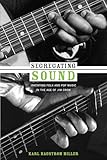Segregating sound : inventing folk and pop music in the age of Jim Crow / Karl Hagstrom Miller.
Material type: TextSeries: Refiguring American music: Publisher: Durham [NC] : Duke University Press, 2010Description: ix, 372 pages ; 24 cmContent type: text Media type: unmediated Carrier type: volumeISBN: 9780822347002Subject(s): Music and race -- Southern States -- History -- 19th century | Music and race -- Southern States -- History -- 20th century | Folk music -- Southern States -- History -- 19th century | Folk music -- Southern States -- History -- 20th century | Popular music -- Southern States -- 19th century | Popular music -- Southern States -- 20th century | African Americans -- Segregation | African Americans -- Segregation | Folk music | Music and race | Popular music | Southern States | Folkmuziek | Segregatie | Zwarten | Populaire muziek | Zuidelijke staten | Rassentrennung | Musik | Schwarze | Folk music | Unterhaltungsmusik | Popmusik | USA -- Südstaaten | Jump Jim Crow | Musik | Schwarze | USA -- Südstaaten | 1800-1999Genre/Form: History.DDC classification: 781.64089/00973 LOC classification: ML3551 | .M56 2010Other classification: 24.65
TextSeries: Refiguring American music: Publisher: Durham [NC] : Duke University Press, 2010Description: ix, 372 pages ; 24 cmContent type: text Media type: unmediated Carrier type: volumeISBN: 9780822347002Subject(s): Music and race -- Southern States -- History -- 19th century | Music and race -- Southern States -- History -- 20th century | Folk music -- Southern States -- History -- 19th century | Folk music -- Southern States -- History -- 20th century | Popular music -- Southern States -- 19th century | Popular music -- Southern States -- 20th century | African Americans -- Segregation | African Americans -- Segregation | Folk music | Music and race | Popular music | Southern States | Folkmuziek | Segregatie | Zwarten | Populaire muziek | Zuidelijke staten | Rassentrennung | Musik | Schwarze | Folk music | Unterhaltungsmusik | Popmusik | USA -- Südstaaten | Jump Jim Crow | Musik | Schwarze | USA -- Südstaaten | 1800-1999Genre/Form: History.DDC classification: 781.64089/00973 LOC classification: ML3551 | .M56 2010Other classification: 24.65 | Item type | Current library | Call number | Copy number | Status | Notes | Date due | Barcode |
|---|---|---|---|---|---|---|---|
 Books
Books
|
Female Library | ML3551 .M56 2010 (Browse shelf (Opens below)) | 1 | Available | STACKS | 51952000195627 | |
 Books
Books
|
Main Library | ML3551 .M56 2010 (Browse shelf (Opens below)) | 1 | Available | STACKS | 51952000195634 |
Browsing Main Library shelves Close shelf browser

|

|

|

|

|

|

|
||
| M32.8 .J64 2019 The library of light | M32.8 .J64 2019 The library of light | M1630.18 .S74 2016 The Pearl | ML3551 .M56 2010 Segregating sound : inventing folk and pop music in the age of Jim Crow / | ML3790 .T395 2012 The sounds of capitalism : advertising, music, and the conquest of culture / | ML3800 .S37 2016 Understanding music : philosophy and interpretation / | ML3805 .G56 2016 Physics of the piano / |
Includes bibliographical references (pages 327-350) and index.
Tin Pan Alley on tour : the Southern embrace of commercial music -- Making money making music : the education of Southern musicians in local markets -- Isolating folk, isolating songs : reimagining Southern music as folklore -- Southern musicians and the lure of New York City : representing the South from coon songs to the blues -- Talking machine world : discovering local music in the global phonograph industry -- Race records and old-time music : the creation of two marketing categories in the 1920s -- Black folk and hillbilly pop : industry enforcement of the musical color line -- Reimagining pop tunes as folk songs : the ascension of the folkloric paradigm -- Afterword : "All songs is folk songs."
Karl Hagstrom Miller argues that the categories that we have inherited to think and talk about southern music bear little relation to the ways that southerners long played and heard music. Focusing on the late nineteenth century and the early twentieth, Miller chronicles how southern music--a fluid complex of sounds and styles in practice--was reduced to a series of distinct genres linked to particular racial and ethnic identities. The blues were African American. Rural white southerners played country music. By the 1920s, these depictions were touted in folk song collections and the catalogs of "race" and "hillbilly" records produced by the phonograph industry. Such links among race, region, and music were new. Black and white artists alike had played not only blues, ballads, ragtime, and string band music, but also nationally popular sentimental ballads, minstrel songs, Tin Pan Alley tunes, and Broadway hits. In a cultural history filled with musicians, listeners, scholars, and business people, Miller describes how folklore studies and the music industry helped to create a "musical color line," a cultural parallel to the physical color line that came to define the Jim Crow South. Segregated sound emerged slowly through the interactions of southern and northern musicians, record companies that sought to penetrate new markets across the South and the globe, and academic folklorists who attempted to tap southern music for evidence about the history of human civilization. Contending that people's musical worlds were defined less by who they were than by the music that they heard, Miller challenges assumptions about the relation of race, music, and the market.
1 2

There are no comments on this title.